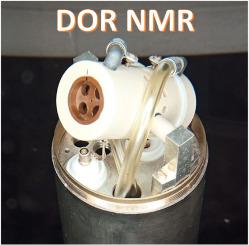当前位置:
X-MOL 学术
›
Solid State Nucl. Magn. Reson.
›
论文详情
Our official English website, www.x-mol.net, welcomes your feedback! (Note: you will need to create a separate account there.)
Double-rotation (DOR) NMR spectroscopy: Progress and perspectives
Solid State Nuclear Magnetic Resonance ( IF 3.2 ) Pub Date : 2024-03-06 , DOI: 10.1016/j.ssnmr.2024.101923 David L. Bryce
Solid State Nuclear Magnetic Resonance ( IF 3.2 ) Pub Date : 2024-03-06 , DOI: 10.1016/j.ssnmr.2024.101923 David L. Bryce

|
Double-rotation (DOR) solid-state NMR spectroscopy is a high-resolution technique developed in the late 1980s. Although multiple-quantum magic-angle spinning (MQMAS) became the most widely used high-resolution method for half-integer spin quadrupoles after 1995, development and application of DOR NMR to a variety of chemical and materials science problems has endured. This Trend article recapitulates the development of DOR NMR, discusses various applications, and describes possible future directions. The main technical limitations specific to DOR NMR are simply related to the size of the double rotor system. The relatively large outer rotor (and thus coil) used for most applications over the past 35 years translates into relatively low rotor spinning frequencies, a low filling factor, and weak radiofrequency powers available for excitation and for proton decoupling. Ongoing developments in NMR instrumentation, including ever-shrinking MAS rotors and spherical NMR rotors, could solve many of these problems and may augur a renaissance for DOR NMR.
中文翻译:

双旋转(DOR)核磁共振波谱:进展与展望
双旋转 (DOR) 固态核磁共振波谱是 20 世纪 80 年代末开发的高分辨率技术。尽管多量子魔角自旋 (MQMAS) 成为 1995 年后最广泛使用的半整数自旋四极杆高分辨率方法,但 DOR NMR 在各种化学和材料科学问题上的开发和应用一直在持续。这篇趋势文章概述了 DOR NMR 的发展,讨论了各种应用,并描述了未来可能的方向。 DOR NMR 的主要技术限制仅与双转子系统的尺寸有关。过去 35 年大多数应用中使用的相对较大的外转子(以及线圈)意味着相对较低的转子旋转频率、较低的填充系数以及可用于激励和质子解耦的微弱射频功率。 NMR 仪器的持续发展,包括不断缩小的 MAS 转子和球形 NMR 转子,可以解决其中许多问题,并可能预示着 DOR NMR 的复兴。
更新日期:2024-03-06
中文翻译:

双旋转(DOR)核磁共振波谱:进展与展望
双旋转 (DOR) 固态核磁共振波谱是 20 世纪 80 年代末开发的高分辨率技术。尽管多量子魔角自旋 (MQMAS) 成为 1995 年后最广泛使用的半整数自旋四极杆高分辨率方法,但 DOR NMR 在各种化学和材料科学问题上的开发和应用一直在持续。这篇趋势文章概述了 DOR NMR 的发展,讨论了各种应用,并描述了未来可能的方向。 DOR NMR 的主要技术限制仅与双转子系统的尺寸有关。过去 35 年大多数应用中使用的相对较大的外转子(以及线圈)意味着相对较低的转子旋转频率、较低的填充系数以及可用于激励和质子解耦的微弱射频功率。 NMR 仪器的持续发展,包括不断缩小的 MAS 转子和球形 NMR 转子,可以解决其中许多问题,并可能预示着 DOR NMR 的复兴。































 京公网安备 11010802027423号
京公网安备 11010802027423号